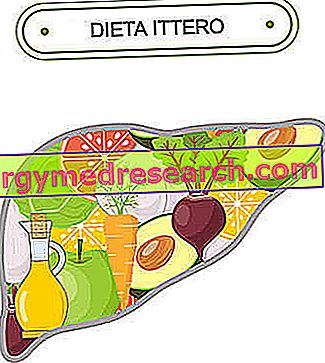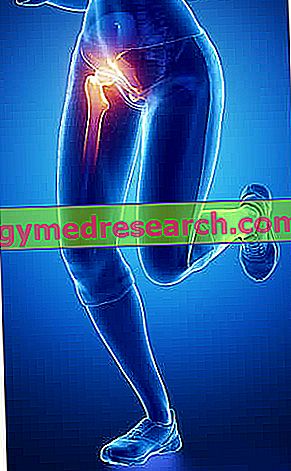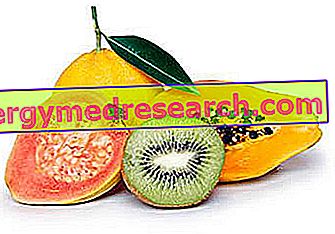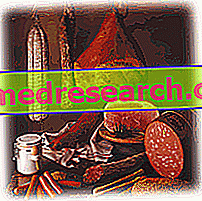Jaundice
Jaundice means a change in the color of the skin, eyes and mucous membranes, which tend to take on a yellowish appearance; this phenomenon is due to the increase in bilirubin in the blood.

Bilirubin is a waste product that the body derives from the "demolition" of the heme, a constituent of hemoglobin (red blood cell protein that allows the transport of oxygen in the blood).
Jaundice should not be confused with other changes in skin pigmentation such as, for example, excess carotenoids, phenolic exposure, suntan lotion, etc.
The diet is able to avoid or improve the anomalies potentially responsible for jaundice. However, each of these causes has a different etiology, which must be treated specifically. This is why in the next chapter we will present a brief subdivision of the pathologies that cause jaundice.
Causes of Icterus and Nutrition
In the body, bilirubin is present in two different forms:
- Direct or conjugated (circulating in the blood and bound to albumin)
- Indirect or unconjugated (necessary for the structuring of digestive bile juices).
Depending on the type of bilirubin that causes jaundice, it is possible to differentiate the diagnosis, therapy and (if necessary) the diet.
By simplifying classification as much as possible, jaundice could be divided into two types:
- Jaundice caused by increased direct or conjugated bilirubin; further differentiable in:
- Hepatocellular, due to injury to liver cells and mainly caused by hepatitis and liver cirrhosis.
- Post hepatic, obstructive and cholestatic, caused by solid bodies that block the passage of bile into the gallbladder or bile ducts. The most common cause is calculosis or lithiasis, but cysts and tumors are not uncommon.
- Jaundice caused by the increase in indirect or unconjugated bilirubin, which is triggered by: favism, pernicious anemia, wrong transfusion and everything that causes erythrocyte destruction.
Hepatocellular Jaundice and Diet
The nutritional causes of hepatocellular jaundice are those affecting hepatitis or liver cirrhosis.
NB . Liver cirrhosis is a consequence of hepatitis (which can be followed by carcinoma), often characterized by functional insufficiency of the organ. These are special conditions that are treated with drugs, surgery and very specific dietary regimes, which also take into account all possible complications (ascites, encephalopathy, portal hypertension, etc.). The diet for cirrhosis and / or carcinoma will NOT be treated in a separate article.
Hepatitis is defined as an inflammation of the liver; the main causes are: viruses, drugs, alcohol and poisons.
In the case of hepatitis, the jaundice diet can be differentiated into: preventive, curative and healing support.
Hepatocellular Preventive Diet
The preventive diet is aimed at reducing the chances of inflammation of the liver, avoiding the infection / intake of:
- Pathogens that can be taken with food. Among all, the most relevant is the virus A (HAV), which is contracted mainly by fecal gold. The foods responsible for the infection for hepatitis A are: raw seafood, infected water, contaminated fruits and vegetables, etc.
To learn more: Diet and Hepatitis A
- Harmful molecules that can damage liver cells. The most widespread poison element is undoubtedly ethyl alcohol. This is especially harmful in case of abuse in the long term, but there have been many cases of acute inflammation of the organ. On the contrary, certain natural poisons (such as fungal ones) are very powerful and damage the liver (sometimes irreversibly) even with a single intake (eg toxins of some fungi of the genus Amanita).
To prevent hepatocellular jaundice it is therefore necessary to avoid the hypothesis of hepatitis paying attention to hygiene and health food.
Prevention of virus infection A requires:
- Procurement of safe, certified foods with traceable and traceable provenance.
- This is especially true for bivalve molluscs (especially mussels and oysters) which, in the wild, retain large viral loads (especially in polluted areas). The case of bivalve molluscs is one of the few in which the animals raised are qualitatively superior to those fished.
- Fruit and vegetables may also be contaminated with virus A, especially if they are irrigated with polluted water (eg canal). To prevent the disease it is therefore necessary to wash them and peel them carefully.
NB. Cooking effectively eliminates the viral load of HAV.
- Always with regard to food, it is very important to eliminate the risk of eating poisonous mushrooms. Unlike viruses, many of these toxins are NOT thermolabile and can give the first symptoms after several days, when the bad luck of the liver is now inevitable. The safest way to eat wild mushrooms is to get supplies from official and regular agencies.
- Elimination of alcohol from the diet or compliance with the limit for a healthy and correct diet. This margin is equal to:
- 0 for growing subjects and pregnant women,
- 1 unit from time to time for nurses,
- 1-3 for healthy adults and half for seniors.
The preventive diet the jaundice from hepatitis prohibits, even if "one-off", the intake of large quantities of alcohol.
Healing Hepato-Cellular Diet
The curative diet serves to restore the physiological condition of the liver organ. This type of remedy affects the following cases:
- Food steatosic hepatitis: it is the accumulation of fat in liver cells associated with more or less severe inflammation. The triggering cause is excess food, in particular refined carbohydrates (especially granular saccharose and fructose, syrups and white flours) and "bad" fats (hydrogenated or bifractionated and saturated vegetables). A sedentary lifestyle plays a predisposing role.
- Alcoholic steatosic hepatitis: it appears as the previous one. The trigger is the excess alcohol associated with a sedentary lifestyle.
- Mixed steatosic hepatitis: it is the union of the two previous ones.
The diet against jaundice caused by steatosic hepatitis includes:
- Reduction of total calories if food or mixed (low-calorie diet), AVOIDING fasting
- Elimination of the triggering factor or factors: junk foods containing refined sugars and bad fats, and / or alcoholic beverages
- Elimination of unnecessary drugs, unnecessary supplements, excess food additives (sweeteners, colorings) etc.
- Increased motor activity
- Increased consumption of fresh and unprocessed foods, especially promoting the use of vegetables, fruits, whole grains and legumes. These are rich in useful nutrients such as: fiber, omega 3 fatty acids, vitamins, minerals, other antioxidants and molecules beneficial for the liver (silymarin and cynarin).
To learn more: Diet for hepatic steatosis
Hepatocellular Jaundice Support Diet
It occurs when the preventive diet has had no effect.
The support diet is aimed at supporting the body in healing; the most indicative examples are diets for hepatitis A, B and C.
It is very similar to the curative one, but it does not necessarily have to be IPO-caloric. If the inflammation is attributable to a pathogenic or poisonous agent, reducing calories would have no positive impact.
Instead it is necessary:
- Prevent from bringing harmful molecules that would surely worsen the circumstance (ethyl alcohol, bad fats and sugars if in excess, additives, etc.)
- Promote the intake of beneficial molecules (omega 3, antioxidants, mineral salts, etc.).
Cholestatic Jaundice and Diet
The obstructive cholestasic jaundice can have many causes, but the only one with a nutritional origin is gall bladder gallstones.
These "pebbles" (large or small) are formed by an imbalance between the various "ingredients" of bile juice. They can be based on cholesterol or pigmented.
Without going into detail, let us remember that the stones are formed more frequently in predisposed subjects, even more in women and the elderly, BUT they also have a very important alimentary etiology.
The dietary factors that predispose to gall bladder stones are:
- Diet too abundant in cholesterol and "bad" fats (saturated or hydrogenated).
- Diet too low of "good" (unsaturated) fats and cholesterol.
- Dehydration. NB . All three cause an imbalance in the composition of the bile and the consequent separation-deposit of material.
- Prolonged fasts, which reduce the emptying of bile.
- Obesity and type 2 diabetes mellitus, which cause an excessive increase in insulin and triglyceridemia. Both predispose directly and indirectly to gallstones.
- Sedentary lifestyle. Exercise promotes peristalsis (contraction) of the gallbladder and emptying of bile.
- Constipation and fiber deficiency. Both related to biliary lithiasis.
- To learn more: Feeding and Gallstones
The diet for cholestatic jaundice is preventive; the fundamental principles are:
- Energy supply that ensures weight stability or, in the case of overweight, a gradual weight loss; it is advisable not to lose more than 3kg a month.
- 25-30% of total calories from lipids. Most must be unsaturated and at least 2.5% of an essential polyunsaturated type. In practical terms, it is necessary to prefer: cold-pressed vegetable oils (eg extra virgin olive oil), dried fruit, blue fish (sardines, mackerel, bonito etc.) and edible algae. On the contrary, it is better to reduce to a minimum: sausages, fatty cheeses, bacon and ribs, butter, cream, lard, lard, sweet and savory snacks, margarines, fried foods, palm oil, etc.
- Reduction of foods with large glycemic loads and high glycemic index, preferring foods rich in fiber and water in moderate portions. It is advisable to eliminate sweet and savory snacks, cakes and croissants, large portions of potatoes, pasta, bread and pizza made with refined flour. On the contrary, prefer the contribution of modest quantities of whole grains (rye, spelled, corn, rice, etc.), legumes (beans, chickpeas, lentils, etc.), vegetables (salad, radicchio, zucchini, cabbage, etc.) and sweet fruit ( oranges, strawberries, kiwi, apples, grapefruit, etc.). In addition to fiber, water, vitamins and mineral salts, these products are rich in phenolic antioxidants and plant lecithins.
- Be sure to give proper weight to the thirst stimulus. The motor activity (which already favors the emptying of the gallbladder) plays a very important function in the regulation of all physiological impulses (hunger, evacuation, etc.)
- Favor the contribution of food / medicinal plants that stimulate peristalsis of the gallbladder; these are called cholagogues (or cholecinetics) and the best known are: chicory, rhubarb, milk thistle, aloe, dandelion, rosemary and boldo.
- See also Diet and Gallbladder Calculations
Hemolytic Jaundice and Diet
Hemolytic jaundice is caused by the destruction of red blood cells. In the dietary field, this very serious reaction can take place by favism and pernicious anemia.
The diet for favism is only preventive; in the case of pernicious anemia, on the other hand, it also acquires a therapeutic function.
- Favism is a disease based on the hereditary deficiency of an enzyme (6-glucose-phosphate dehydrogenase). Already lacking, if this enzyme is inhibited by the ingestion of certain legumes, herbal drugs, drugs or other substances, it causes the destruction of erythrocytes with consequent jaundice. That for favism is a simple exclusion diet and must completely eliminate: fava beans, peas and Verbena x Hybrida . Furthermore, it is recommended to avoid: naphthalene and some drugs or other substances such as: analgesics, antipyretics, antimalarials, salicylates, certain chemotherapeutic agents, quinidine, methylene blue, etc.
Pernicious anemia is a disease with nutritional etiology, which increases the demolition of red blood cells (motif of jaundice) and is associated with the so-called atrophic glossitis (smooth and reddened tongue at the edges). The main cause is vitamin B12 or cobalamin deficiency, which occurs by:
- Food defect: diet lacking food of animal origin.
- Shortage of intrinsic factor: a molecule secreted by the stomach necessary for the absorption of cobalamin. It can occur in the case of certain stomach diseases such as atrophic gastritis.
- Complication of the terminal ileum: part of the intestine in which vitamin B12 is absorbed. This is the case with surgical resections, sometimes necessary in chronic intestinal diseases such as Crohn's disease.
It is therefore essential that the diet for pernicious anemia responsible for haemolytic jaundice has the following characteristics:
- Richness of foods containing vitamin B12: liver, kidney, heart, bivalve molluscs (clams, oysters, etc.), cephalopod molluscs (eg octopus), fish, meats etc.
- Richness of iron and folic acid: although not directly involved in pernicious anemia, they can aggravate or improve this condition. The bioavailable iron is contained above all in foods of animal origin (egg yolk, meat, fish, molluscs, etc.), while folic acid is found in raw vegetables and fruits (kiwi, lettuce, avocado, endive, agretti, oranges) etc).
NB . in the case of hemolytic jaundice from pernicious anemia, the most timely and decisive intervention is not the diet but the injection of vitamin B12.



